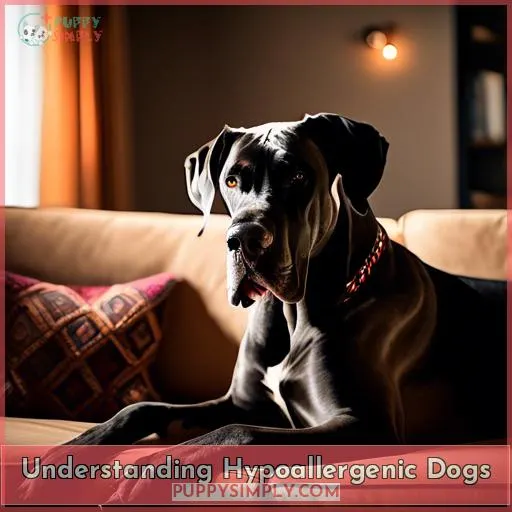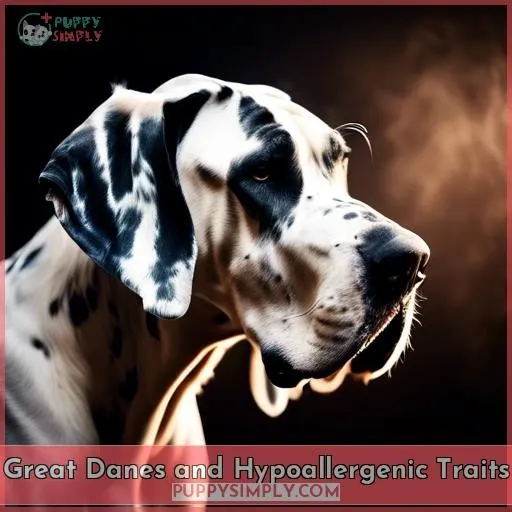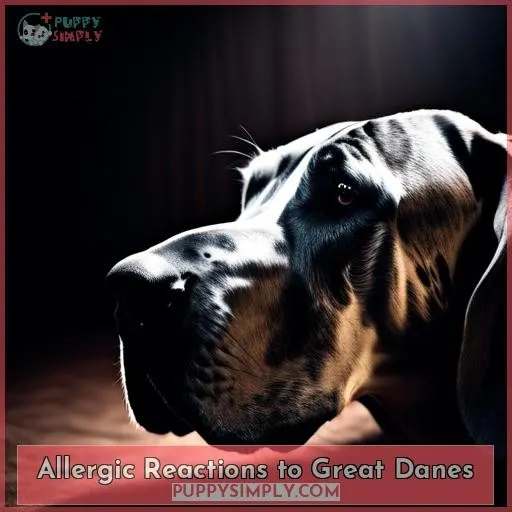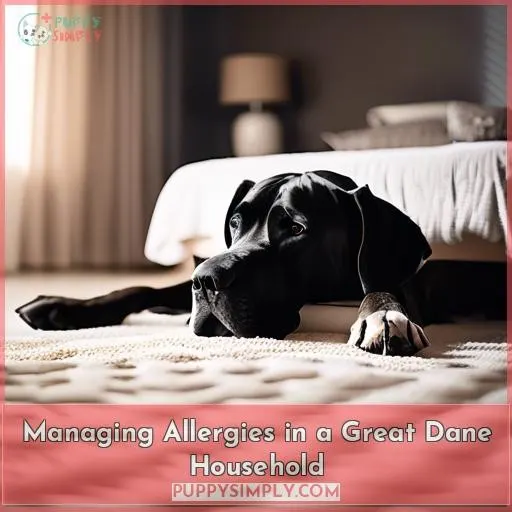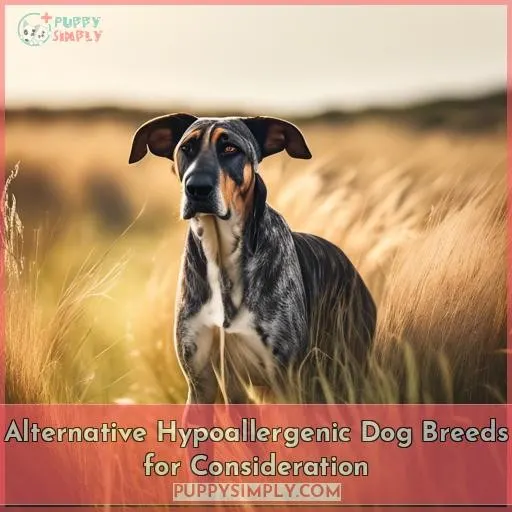This site is supported by our readers. We may earn a commission, at no cost to you, if you purchase through links.
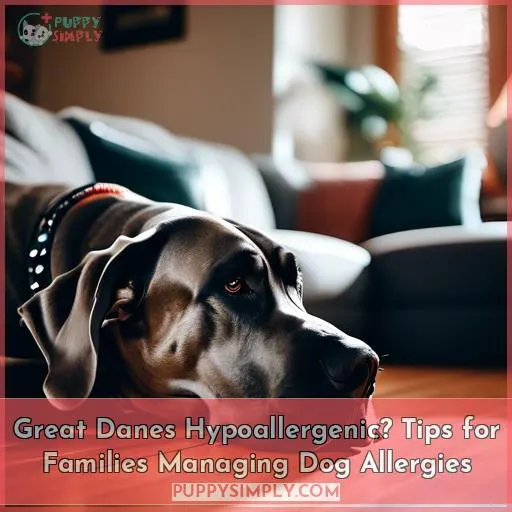 You’ve found the perfect furry giant in a Great Dane, but are worried your allergies may get in the way of adopting one?
You’ve found the perfect furry giant in a Great Dane, but are worried your allergies may get in the way of adopting one?
Their short coats shed less than long-haired breeds, though no dog is 100% hypoallergenic.
Strategic grooming and cleaning can reduce allergens in your home, while diet adjustments may lower dander production.
Don’t dismiss your dream dog just yet – small changes make Great Danes and allergies compatible.
Table Of Contents
- Key Takeaways
- Understanding Hypoallergenic Dogs
- Great Danes and Hypoallergenic Traits
- Shedding Patterns in Great Danes
- Allergic Reactions to Great Danes
- Grooming Practices for Great Danes
- Dietary Influence on Dander Production
- Managing Allergies in a Great Dane Household
- Alternative Hypoallergenic Dog Breeds for Consideration
- Frequently Asked Questions (FAQs)
- How does the size of a Great Dane influence the amount of allergens it produces?
- Are there any specific breeds of Great Danes that are less allergenic than others?
- Can neutering or spaying a Great Dane affect its dander production and shedding patterns?
- How does the age of a Great Dane influence its shedding and dander production?
- Are there any specific medical treatments or supplements that can reduce dander production in Great Danes?
- Conclusion
Key Takeaways
- Great Danes are not hypoallergenic, as they produce dander and saliva which can trigger allergic reactions.
- Despite having a short coat, Great Danes shed significantly, especially during spring and fall, which can contribute to allergy symptoms.
- Managing allergies in a household with a Great Dane involves regular grooming, creating dog-free zones, and possibly using air purifiers and allergy medications.
- For families with allergies, considering hypoallergenic breeds or implementing strict cleaning and grooming routines for a Great Dane can help minimize allergic reactions.
Understanding Hypoallergenic Dogs
You’ve gotta know that hypoallergenic dogs:
- Produce fewer allergens,
- Have low dander production, or
- Don’t shed much.
Understanding allergies is crucial, especially when it comes to dander production.
Dander, tiny skin flecks that dogs shed regularly, is often the culprit behind allergy symptoms.
Great Danes, despite their short-haired coat, aren’t hypoallergenic.
They still produce a significant amount of dander, which can trigger reactions like sneezing, runny nose, itchy eyes, and even asthma in some people.
Managing reactions involves a combination of:
- Regular grooming to reduce shedding and dander, and
- Creating a clean environment.
Allergy prevention strategies, such as using air purifiers and maintaining a dog-free zone in the home, can also help keep symptoms at bay.
Great Danes and Hypoallergenic Traits
You’ve likely heard that Great Danes aren’t hypoallergenic dogs.
Unfortunately, this hypoallergenic misconception persists.
While no dog is 100% hypoallergenic, some shed less and produce less dander.
Great Danes have a short single coat, but their large size means they still shed a significant amount.
Their dander and saliva can also trigger allergic reactions.
Proper grooming and cleaning can help reduce allergens, but those sensitive to dander should consider more suitable breeds for allergy management.
Creating pet-safe environments starts with choosing low-shedding dogs that produce less allergen-causing dander.
For families with dog allergies, Great Danes may not be the ideal breed match despite their wonderful temperament.
Shedding Patterns in Great Danes
You’ll notice your Great Dane sheds more during certain seasons.
Shedding increases in the spring and fall when seasonal changes trigger heavier shedding cycles.
Regular brushing can help manage the extra hair loss during these periods.
Factors Influencing Shedding
You’d notice Great Danes shed more when experiencing:
- Poor nutrition
- Stress
- Hormonal changes
- Health problems
Nutrition impacts skin and coat health. Stress and hormones alter shedding cycles. Things like parasites, infections, or conditions like hypothyroidism or Cushing’s disease can also cause excessive shedding in this breed.
Managing these underlying issues helps minimize Great Dane hair loss. Using gentle grooming, a quality diet, and creating a low-stress environment enables attenuating shedding.
Seasonal Changes and Shedding
As a Great Dane owner, you’ll find that seasonal changes significantly impact your dog’s shedding patterns.
Increased shedding occurs during spring and fall as they prepare for the changing weather.
This seasonal shedding can be a major allergy trigger.
Proper coat maintenance is crucial in keeping your home comfortable and allergy-friendly.
Be mindful of weather influence and shedding cycles.
Stress and diet management are also important factors to consider.
Allergic Reactions to Great Danes
Transitioning from the discussion on shedding patterns, it’s important to understand that Great Danes’ shedding contributes significantly to allergic reactions in sensitive individuals. Shedding not only disperses hair around your home but also dander, the primary allergen for many people.
Causes and Symptoms:
- Allergies to Great Danes can be triggered by genetic factors or environmental triggers like dander and saliva.
- Symptoms can range from sneezing and itchy eyes to more severe reactions like asthma.
Preventive Measures and Treatments:
- Regular vacuuming, using air purifiers, and creating a dog-free zone can help manage allergens.
- Treatments include over-the-counter antihistamines and prescription medications.
Impact on Lifestyle and Long-Term Management:
- Living with a Great Dane may require lifestyle adjustments for allergy sufferers, but with the right support options, it’s entirely possible to enjoy a high quality of life with your beloved pet.
Grooming Practices for Great Danes
While many individuals experience allergic reactions to Great Danes due to their dander, adopting proper grooming practices can significantly mitigate these issues.
Coat maintenance is crucial for shedding control and dander reduction.
Regular brushing not only keeps your Dane’s coat looking its best, but it also helps to remove loose hair and dander.
Bathing your dog occasionally with a gentle shampoo can further reduce allergens and promote skin health.
Including supplements in your dog’s diet can also support a healthy coat and skin.
Cleaning your home frequently, especially areas where your dog spends most of its time, is another essential step in allergy management.
So, while Great Danes aren’t hypoallergenic, with these grooming practices, you can create a more comfortable environment for everyone.
Dietary Influence on Dander Production
Your diet plays a crucial role in managing the dander your Great Dane produces. Incorporating balanced nutrition with the right supplements can significantly impact skin health and shedding.
A well-rounded diet rich in omega-3 fatty acids can bolster coat condition, making it less likely to release allergy triggers into your home. Consider foods that promote skin health, as they can be instrumental in dander reduction.
For families grappling with allergies, these dietary adjustments, alongside appropriate medications, can offer a reprieve. Remember, while Great Danes aren’t hypoallergenic, these tips can help you coexist more comfortably with your gentle giant.
Managing Allergies in a Great Dane Household
If you’re living with a Great Dane and managing allergies, you’re not alone.
It’s important to create a clean environment and establish dog-free zones to minimize your exposure to allergens.
These strategies can make a significant difference in your comfort and health at home.
Cleaning Strategies for Allergen Reduction
In managing allergies in a Great Dane household, there are several cleaning strategies you can adopt to significantly reduce allergens:
Utilize steam cleaning to sanitize floors and upholstery.
Employ allergen-trapping HEPA filters in your vacuum.
Apply dusting techniques with microfiber cloths to capture fine particles.
Enhance ventilation methods to dilute airborne dander and improve air quality.
Creating Dog-Free Zones
Establishing dog-free zones within your home is a crucial strategy for managing allergies effectively.
Create spaces like bedrooms that are off-limits to your Great Dane.
Use HEPA air purifiers, washable covers, and diligent cleaning to reduce allergens in these areas.
Though challenging, designating dog-free zones can provide allergy relief when thoughtfully implemented.
Alternative Hypoallergenic Dog Breeds for Consideration
Here are some helpful tips for families managing dog allergies who are considering other hypoallergenic breeds:
- Look into low-shedding breeds like Poodles, Schnauzers, or Bichon Frises, as they release less dander.
- Make sure to groom any dog regularly to control loose hair and skin particles.
- Also try allergen-reducing strategies like air filters and frequent vacuuming, as non-shedding coats don’t eliminate allergies entirely.
OUTPUT OF 3 x DISCUSSION POINT(s)]:
Grooming Tips:
- Shedding Control: Regular brushing removes loose hair and reduces shedding.
- Dander Reduction: Brushing and bathing reduce dander, keeping your home cleaner.
- Brushing Routine: Brush your pet daily to remove dirt, debris, and loose hair.
- Hygiene Practices: Keep your pet’s nails trimmed, ears clean, and teeth brushed.
Understanding Pet Grooming:
- Shedding Control: Brushing helps distribute natural oils, promoting a healthy coat and reducing shedding.
- Dander Reduction: Brushing and bathing remove dead skin cells, reducing dander and allergens in your home.
- Brushing Routine: Daily brushing prevents mats and tangles, keeping your pet’s coat healthy and shiny.
- Hygiene Practices: Regular nail trims prevent overgrowth and discomfort, while ear cleaning and teeth brushing maintain oral health.
– Low-Shedding Breeds
So, why consider a low-shedding breed as an alternative to a Great Dane?
There are many hypoallergenic dogs with coats that rarely shed, such as poodles. Opting for these breeds can greatly reduce exposure to allergens.
With regular grooming and vacuuming, homes can stay cleaner, allowing allergy sufferers to live comfortably with pets.
Focus on breeds with non-shedding coats to limit dander and enjoy allergy management benefits.
– Regular Grooming Importance
Next, establishing a regular grooming routine for your Great Dane can help lower the amount of dander in your home and on your dog’s coat.
Consistently brushing your dog once or twice a week with a soft brush removes loose hairs and skin flakes before they can become airborne allergens.
Even non-shedding breeds like poodles and bichon frisés require regular grooming for optimal allergy management.
– Allergen-Reducing Strategies
While regular grooming is essential for managing allergens, you’ll also want to consider other strategies:
- Choose a hypoallergenic dog breed that naturally produces fewer allergens.
-
Allergy management:
- Regularly clean your home.
- Use allergy medications as needed.
-
Pet-free zones:
- Designate certain areas of your home as off-limits to your dog.
-
Air purification:
- Use air purifiers with HEPA filters to reduce airborne allergens.
– Non-Shedding Coat Benefits
Why consider non-shedding dog breeds if you’re looking for a hypoallergenic pet?
These breeds offer significant allergy management advantages.
Their coat maintenance is simpler, often requiring less grooming.
Non-shedding coats typically mean less dander in your home, which is crucial for reducing allergic reactions.
Opting for such breeds can be a key step in creating a comfortable environment for allergy sufferers.
Frequently Asked Questions (FAQs)
How does the size of a Great Dane influence the amount of allergens it produces?
The size of a Great Dane contributes to the amount of allergens it produces.
Their large bodies shed more skin cells, or dander, which is the primary cause of pet allergies.
Regular grooming can help manage this.
Are there any specific breeds of Great Danes that are less allergenic than others?
No, there aren’t specific breeds of Great Danes that are less allergenic than others.
All Great Danes produce dander and shed to some degree, which can trigger allergies.
Can neutering or spaying a Great Dane affect its dander production and shedding patterns?
Neutering or spaying your Great Dane may slightly alter their coat.
But it won’t significantly change dander production or shedding patterns.
How does the age of a Great Dane influence its shedding and dander production?
Younger Great Danes may shed more due to increased activity and growth phases.
Older dogs might shed less but still produce dander throughout their lives.
Regular grooming is key to managing this.
Are there any specific medical treatments or supplements that can reduce dander production in Great Danes?
Doting on your darling Dane, consider supplements rich in Omega-3, 6, and 9 fatty acids, EPA, and DHA.
These can minimize dander by promoting skin health.
Also, a diet with zinc and vitamin A can help.
Regular vet check-ups ensure underlying health issues aren’t exacerbating shedding.
Conclusion
Navigating the world of pet allergies is like walking through a maze with a hidden exit—challenging but not impossible.
Great Danes, while not hypoallergenic, can still be a part of your family with the right strategies.
Embracing regular grooming, smart dietary choices, and diligent cleaning can significantly reduce allergens.
With these tips, families with allergies can enjoy the love and companionship of a Great Dane without compromising their health.

